

Musculoskeletal diseases affect the US economy through direct medical costs and through lost wages. Changes in medical care, new methods of treatment, new drugs, and the overall economy all affect the impact of musculoskeletal diseases. Musculoskeletal diseases are a major burden on the overall economy.
Over the period 1996 to 1998 through 2009 to 2011, slight changes in the proportion of total medical care expenditures devoted to ambulatory physicians visits (from 31% to 34% of total) and to inpatient care (from 36% to 29%) occurred. However, the share of musculoskeletal health care costs devoted to prescription medications increased the most, growing by more than 60%, from 14% to 23% of total cost. Computed in 2011 dollars, the mean annual prescription cost per person increased 167%, from $665 to $1,778. During this time, development of biologic agents for several inflammatory conditions, particularly rheumatoid arthritis, occurred, as well as the widespread use of the cox-2 inhibitors (coxibs) for musculoskeletal pain, and may have accounted for some of the rapid increase. However, the growth in per-person total expenditures for prescription drugs has slowed. From 1998 to 2000 through 2002 to 2004, annual growth in expenditures for prescription drugs averaged 15%, but since 2004 has averaged about 3% a year. (Reference Table 10.4 PDF [1] CSV [2])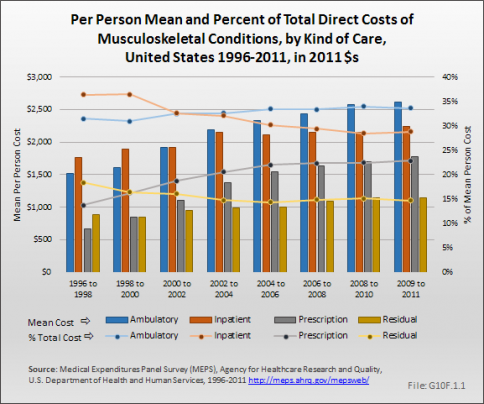
The per person increment in ambulatory care expenditures for musculoskeletal diseases grew by 51% between 1996 to 1998 and 2009 to 2011, from $570 to $859 in 2011 dollars. The increment for inpatient care more than doubled, from $102 in the 1996 to 1998 to $313 in 2009 to 2011. Ambulatory care represents the largest component of the increment in expenditures, indicative of the importance of ambulatory care in musculoskeletal diseases relative to other condition groups. (Reference Table 10.5 PDF [3] CSV [4])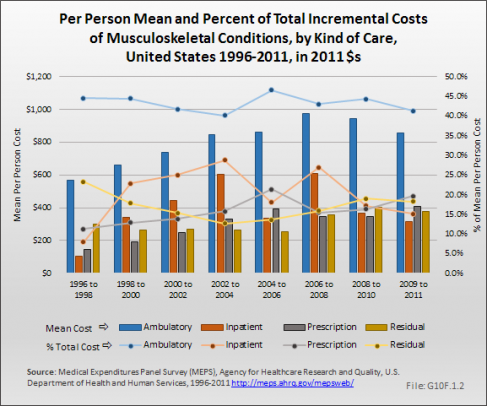
In the studies conducted by Rice and colleagues starting in the early 1960s, indirect cost associated with earnings losses due to musculoskeletal diseases constituted between 38% and 59% of the total cost of these diseases.1,2,3,4,5 The percentage shifted because in various eras, medical costs were rapidly escalating while earnings stagnated (1970s) and in other times wage growth exceeded the increase in medical costs (1960s and late 1990s). Analysis of the Medical Expenditures Panel Survey to estimate direct and indirect cost (ie, the cost of lost wages due to musculoskeletal conditions for persons age 18 to 64 years with a work history) as a proportion of GDP shows a slow but steady increase in the share of GDP accounted for by musculoskeletal conditions, from about 3.4% of GDP in 1996 to 1998 to about 5.7% in 2009 to -2011, an increase of 67%.6,7 (Reference Table 10.14 PDF [5] CSV [6])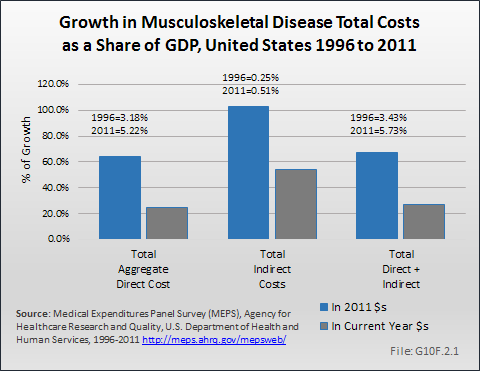
The method to estimate earnings losses is based on the notion that presence of musculoskeletal conditions is one among many factors affecting employment. Thus, estimates of total earnings losses, grew from 1996 to 1998 through the mid 2000s, then declined substantially with the recession because it became more difficult to differentiate the employment situation of persons with musculoskeletal conditions from that of similar individuals. However, when other characteristics of individuals were taken into account, the estimate of incremental earnings losses continued to trend upward, despite the recession. Overall, the average increment in earnings losses grew from $949 in 1996 to 1998 to $2,063 in 2009 to 2011, or by more than 100%. (Reference Table 10.12 PDF [7] CSV [8])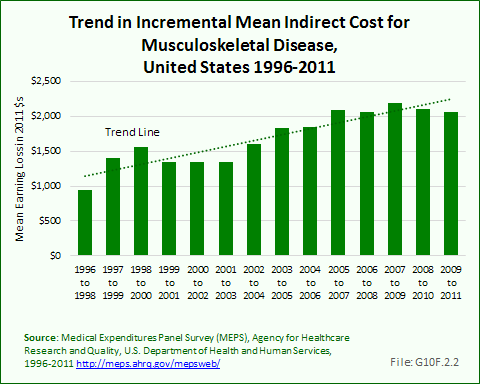
Estimates of earnings losses are limited to persons age 18 to 64 years, both because the number of workers older than 65 years in MEPS is too small to permit statistically reliable estimates in this age group and because in the United States, most workers retire by that age. However, it is probable that some individuals with musculoskeletal diseases would continue working past the age of 65 years in the absence of the condition. Similarly, the tabulation of earnings losses is limited to those who have established a work history either prior to or after the onset of disease. There may be some among those without a work history who would have begun to work in the absence of a musculoskeletal disease, but who never had the opportunity to do so. Thus, the magnitude of earnings losses shown should be considered a conservative estimate.
As of 1996 to 1998, about 48.5 million persons with a musculoskeletal disease had established a work history. On average, these individuals earned $596 in 2011 dollars less than those without musculoskeletal conditions; their earnings losses aggregated to $28.9 billion. By 2009 to 2011, the number of persons with musculoskeletal diseases and a work history had grown to over 63.3 million. On average, these workers had earnings losses of $1,224 each, or roughly a doubling. Aggregate total earnings losses grew to $77.5 billion, despite the decline associated with the recession.
Some of the estimated earnings losses of persons with musculoskeletal diseases might have occurred in the absence of these conditions because of other factors. For example, older workers and women, two groups with high rates of musculoskeletal diseases, have lower employment rates and earnings than the average US worker. The incremental earnings loss measure takes into consideration many of the factors that might cause persons to have lower earnings even without the presence of the musculoskeletal disease. Earnings losses using the incremental measure grew substantially between 1996 to 1998 and 2009 to 2011. In the earlier triad of years, the 48.5 million persons with musculoskeletal diseases and a work history sustained average incremental earnings losses of $949, or $46.1 billion overall, in 2011 dollars. Average incremental earnings losses more than doubled by 2009 to 2011, to $2,063; aggregate incremental earnings losses increased almost three-fold to $130.7 billion.
Using the more expansive definition of musculoskeletal diseases, average earnings losses rose from 1996 to 1998 through 1998 to 2000, but have been falling ever since; as of 2006 to 2008, earnings were actually greater among those included within the more expansive definition of musculoskeletal conditions than among the remainder of the working age population. In parallel, aggregate earnings losses have been falling since 1998 to 2000, turning negative in 2006 to 2008 and reaching -$158.6 billion in 2009 to 2011. (Note: Data on earnings losses of persons meeting the expansive definition of musculoskeletal diseases are not included in the tables.) Estimates of aggregate total earnings losses using the base case definition for this publication have declined from their peak in 2003 to 2005, but still are indicative of an adverse impact on earnings. It follows that the more expansive definition of conditions must necessarily include conditions which are not associated with work loss and resultant earnings losses.
Medical conditions in MEPS are self-reported and may result in misreporting of some conditions. With respect to musculoskeletal diseases, under-reporting might occur when physicians do not provide patients with a discrete diagnosis. For example, osteoarthritis may not be reported because it may be too mild to be recognized or treatment is included with other conditions and not distinct. Over-reporting of a condition could occur when respondents indicate they have a specific form of arthritis, for example, rheumatoid arthritis, even though their physician did not so indicate it. It should be noted that self-reporting of discrete medical conditions is lower than would be expected on the basis of epidemiological studies.1 As a result of differences in reporting, the measures of the aggregate economic impacts of discrete conditions summarized in Table 10.14 and select graphs throughout these pages may differ from those presented in the discussion of specific conditions in prior chapters. These discussions are based on larger samples, such as all musculoskeletal disease, or major subcategories, such as all forms of arthritis. Nevertheless, the data on expenditures do indicate, in broad stroke, the average economic impact for self-recognized disease and for conditions likely to be under-reported, such as osteoarthritis, a conservative estimate of aggregate economic impact. Estimates for discrete musculoskeletal diseases merged four years of MEPS data (2008-2011) to provide more stable estimates given the relatively few cases of each condition reported in individual years.
Average total direct cost for all four conditions studied—disorders of the back, rheumatoid arthritis, osteoarthritis and allied disorders, and gout—are relatively large. Over the period 2008 to 2011, per-person direct costs exceeded $12,000 a year for gout, $11,000 a year for osteoarthritis, $17,000 a year for rheumatoid arthritis, and just under $8,000 for disorders of the back. These costs aggregate to about $141.5 billion for gout, $339.7 for osteoarthritis, $17.8 billion for rheumatoid arthritis, and $141.5 billion for disorders of the back.
Average total earnings losses were highest for rheumatoid arthritis, $13,886 per year, followed by osteoarthritis at $7,548 per year. However, because of the lower prevalence of rheumatoid arthritis, the aggregate impact of the earnings losses for these two conditions were $12.3 billion and $121.8 billion, respectively. Persons with both gout and back disorders actually had higher earnings than the corresponding populations without those conditions. (Reference Table 10.13 PDF [9] CSV [10])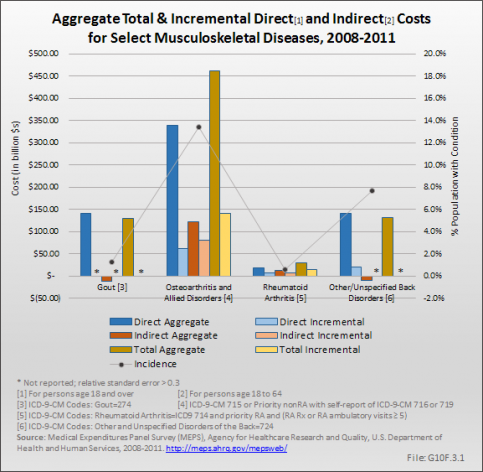
Links:
[1] https://bmus.latticegroup.com/docs/T10005.4.pdf
[2] https://bmus.latticegroup.com/docs/T10005.4.csv
[3] https://bmus.latticegroup.com/docs/T10006.5.pdf
[4] https://bmus.latticegroup.com/docs/T10006.5.csv
[5] https://bmus.latticegroup.com/docs/T10015.14.pdf
[6] https://bmus.latticegroup.com/docs/T10015.14.csv
[7] https://bmus.latticegroup.com/docs/T10013.12.pdf
[8] https://bmus.latticegroup.com/docs/T10013.12.csv
[9] https://bmus.latticegroup.com/docs/T10014.13.pdf
[10] https://bmus.latticegroup.com/docs/T10014.13.csv